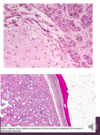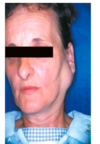Ch. 16 Flashcards
if a pt presents w. targets/raised edematous papules distributed acrally w/ involvement of one or more mucus membrane.. what kind of reaction is this
=erythema multiforme = type IV hypersensitivity

what are aphthous ulcers associated with?
celiac dz
IBD
behcet dz
when does dental plaque biofilm form?
when microorganisms adhere to the surface of some object in a moist environment and begin to reproduce
-microorganisms form an attachment to surface of the object by secreting slimy, glue like substance

what do the oral lesions for melanotic pigmentation present
(see in addison dz)
hemochromatosis
fibrous dysplasia of bone (albirght syndrome)
& Peutz-jegher syndome (pic) - genetic disorder; develop polys & dark spots that appear on various parts of body - greater risk for CA

what is the most common fungal infxn of the oral cavity?
what influences the infxn?
Candidiasis. (also most most freq of human fungal infxns)
influenced by :
- strain of C. albicans
- compostition of normal flora
-
immune status of pt -
- neutrophils, macrophages & Th17 = imp protection against Candida
what is gingivitis
what population is the most prevalent and severe
inflamof the oral mucosa surrounding the teeth caused by accumulation of dental plaque and calculus
plaque => sticky, colorless, biofil that collects btn & on the surface of teeth (AKA dental plaque) –> if not removed - becomes calculus
plaque beneath gumline –> gingivitis (can contribute to development of caries)
*adolescence*
What population is are these typically found in?

=pyogenic granuloma
gingiva of children, young adults & pregnant women (“pregnancy tumor”)
What population presents with torus palatinus the most?
what are characteristics of torus palatinus
F>M
= asymp bony outgrowth (exostoses) bc genetics or environment
=localized, benign benign protrusions
no cartilage involement
periodontits may be apart of systemic and/or immunodeficiency syndromes
which ones??
AIDS
Leukemia
Crohns
Diabetes
Down syndrome
Sacoidosis
syndromes w/ defects in neutrophils
infective endocarditis
pul or brain abscess
what is the etiology of SCC
1. HPV
2. tobacco/alc
3. betel quid/paan (india/asia) = combo of betel leaf, areca nut and slacked lime (aka gutka)
- a__ctinic radiation (sunlight) & esp in pipe smokers (lower lip)
- seen a rise in oral SCC (esp tongue) in < 40 y/o who doesnt smoke or have HPV - No known risk factors
How do you differentiate aspergillus fumigatis from mucor
aspergillus - septated 45 degree uniform branches
mucor- nonseptated 90 degree branches

What is the etiology of sialadenitis
etiology = inflam (-itis) of salivary gland
- trauma - mucocele (MC) & ranula
- autoimmune dx - sjogrens
- viral- mumps = MCC
- bacterial- staph aureus/strep viridins
what is the range of differentiation for SCC
range from well-differentiated keratinizing neoplasms
to
anaplastic, maybe sarcomatoid tumors
& also range in growth - slow to rapidly growing lesions
*degree of histological differentiation (determined by degree of keratinization) IS NOT correlated w/ behavior

what do the oral lesions look like in myeloid neoplasms ( tumors w/ monocytic differentiation)
=AML w/ monocytic maturation - nonspecific esterase (+); see monoblasts/mature monocytes in blood
infiltrate the skin (luekemia cutis) & gingiva
present before pancytopenia presents

a pt w/ DM presents complaining of facial pain and numbness w/ progressive conjunctival suffusion and blurry vision. after looking at the noncontrast CT which shows complete opacification of the lumen of the right maxillary sinus w/ bony erosion, what is on your DDx
what are you worried about?

Rhinocerebral mucormycosis
worried that infxn will spread to the orbits, cause cavernous sinus thrombosis and possibly invade basilar brain
what are characteristics of salivary gland neoplasms
relatively uncommon (<2 % of tumors in humans)
adults - F slightly more than male
5% in children < 16 yo
benign tumors - 50s-70s & malignant = later
(ex: pleomorphic adenoma, warthin tumor, mucoepideral carcinoma, adenoid cystic carcinoma)
compare the 5-yr survival rate of :
smoke/alc related SCC (early stage)
smoke/alc related SCC (late stage)
HPV
smoke/alc related SCC (early stage): 80%
smoke/alc related SCC (late stage): 20%
HPV-SCC: Better than non-HPV associated
*2nd primary tumor of oral cavity = 3-7% –> higher risk of malignancy
what is the clinical presentation of HNSCC
non-specific symptoms - sore throat, ear ache, pain on swallowing, wt loss.
possible metastasis to LN (submandibular & cervical)
If a pt presents w/ gray-white exudative membrane caused by acute pharyngitis/tonsilittis and the underlying cause is a result of EBV.. what does this pt have?
infxous mono
-also see cervical LAD and palatal petechiae

Pt w/ positve pregnancy test comes to your office with oral changes. what are these changes?
pregnancy tumor=
friable, red, pyogenic granuloma protruding from gingiva
how does HSV orofacial infxn present in adults
most = latent HSV-1 in
reactivation = recurrent herpetic stomatitis = at the site of primary inoculation or in adjacent mucosa w/ same ganglion
herpes labialis (pic) = latent in trigeminal ganglion = 1-3 mm vesicles to large bullae - 1st filled w/ clear serous fluid but rapidly rupture to yield painful, red-rimmed shallow ulcerations - clear w/i 3-4 weeks spontaneously
–> intracell and intercell edema (acantholysis)

what are 3 sources of brain abscesses?
- spread of infxn from pericranial contiguous focus (sinuses, middle ear, dental infxns)
- dental infxns, ethmoid/frontal sinusitis
- subacute/chronic otitis media/mastoidosis
which bacteria is most associated with periodontitis in adults
- Aggregatibacter (actinobacillus) actinomycetemcomitans
- Porphyromonas ginginvalis
- Prevotella intermedia
what is the MCC salivary gland lesion
Mucocele
MC in toddlers, young adults and elderly (who are more prone to falling)
= fluid filled on lower lip due to trauma - fluctuant fluid filled lesion (filled w/ mucinous material & lined by organizing granulation tissue)
Tx: complete excision
*NOT A CYST- bc no epithelial lining


































